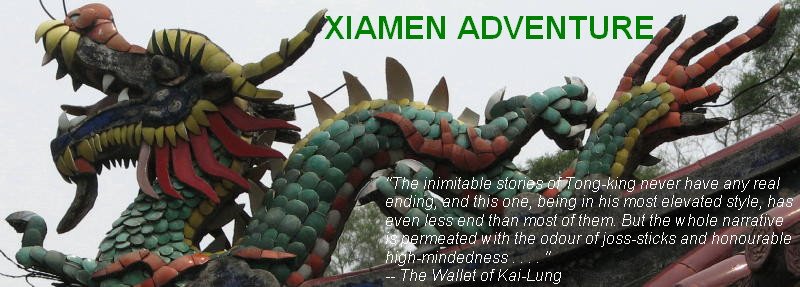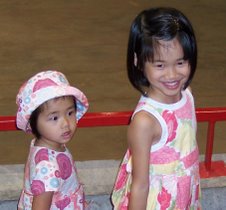 Sometimes when you’ve been anticipating something for a long time, the reality just doesn’t measure up. NOT SO with the terracotta warriors of Xi’an! They are truly fantastic, actually worthy of the designation “Eighth Wonder of the World.”
Sometimes when you’ve been anticipating something for a long time, the reality just doesn’t measure up. NOT SO with the terracotta warriors of Xi’an! They are truly fantastic, actually worthy of the designation “Eighth Wonder of the World.”We started by seeing a short movie-in-the-round (you stand in the center while the movie shows all around you on a 360-degree screen – very cool!) about the construction of Emperor Qin’s mausoleum and the pits for the terracotta warriors. It seemed that the emperor, reigning around 250 B.C., bankrupted his people with high taxes to pay for it all, and conscripted over 720,000 people to work for him rather than in their own fields with resultant famine and poverty. And what he wasn’t doing to destroy the populace of southern China he was doing in northern China by ordering the construction of the Great Wall. Still, he was a heroic figure in some ways, having joined all the kingdoms of China by defeating all the various warlords warring among themselves. And he managed to keep the kingdom together and repel the Mongolian hordes. But his son was not able to continue the Qin dynasty, being defeated by an uprising of the oppressed peasants. They opened the pits, burned everything in sight, stole the weapons the warriors were carrying, and destroyed many of the statues. Burning the underground structures housing the warriors caused further damage to the statues – they were crushed under the weight of the dirt and wooden beams above them.
The making of the statues must have been quite an undertaking. And I didn’t realize this until now – each statue is inscribed with the name of the craftsman who made it! They’ve identified over 80 different craftsmen. Each statue’s body was made using molds. There were various body types – standing archers, kneeling archers, cavalry soldiers complete with horses (the cavalry soldiers are not seated on the horses because the kilns were not big enough, so they stand beside their horses), infantry soldiers, even high-ranking officers. There were also wooden chariots, now rotted away, manned by more terracotta warriors and pulled by terracotta horses. The detail in the soldiers’ uniforms is incredible, down to the stitching on the soles of the kneeling archers’ shoes and the studs holding together the plates of armor. And it seems that the figures were originally painted quite elaborately, but all traces of color disappear almost as soon as the warriors are unearthed because of oxidation. In fact, the archeologists have decided not to unearth any more warriors until they figure out how to preserve the color. How extraordinary this army must have looked when painted!
 The heads were molded, but the faces were not made from molds; each was hand-done and the variety in facial features, hairstyles, head dresses, facial hair and facial expressions is astonishing. The different ethnic minorities in Qin’s empire are represented in those different facial features and hairstyles/head dresses.
The heads were molded, but the faces were not made from molds; each was hand-done and the variety in facial features, hairstyles, head dresses, facial hair and facial expressions is astonishing. The different ethnic minorities in Qin’s empire are represented in those different facial features and hairstyles/head dresses.
 The highlight of the museum is the unromantically named “Pit One,” the largest of the pits of excavated soldiers. It is truly enormous, but only represents a fraction of what is believed to be still buried. The warriors were deployed four across in trenches, as you see them here. The earthen walls between them do not contain more soldiers – these were the walls that held up the roof and tons of dirt over the army’s head (the walls were taller then, of course).
The highlight of the museum is the unromantically named “Pit One,” the largest of the pits of excavated soldiers. It is truly enormous, but only represents a fraction of what is believed to be still buried. The warriors were deployed four across in trenches, as you see them here. The earthen walls between them do not contain more soldiers – these were the walls that held up the roof and tons of dirt over the army’s head (the walls were taller then, of course).
 What a bizarre and extraordinary undertaking to replicate Emperor Qin’s army so that his soul could continue to rule the kingdom he believed would exist underground after his death. And it wasn’t just the army he recreated in terracotta – they’ve also unearthed pits with statues of acrobats and civil officials. And then there are the birds and animals and stables of horses that were buried alive to populate Qin’s underground kingdom (it seems he liked to hunt, so he made sure to have animals available so he could enjoy this pastime after death). The birds, animals and horses all had terracotta attendants with them. And don’t forget the concubines – the new emperor ordered that those who had no children were to be entombed with the dead Emperor Qin. Also buried alive were thousands of officials and workmen who knew the location of Qin’s tomb, so that they could not reveal that secret.
What a bizarre and extraordinary undertaking to replicate Emperor Qin’s army so that his soul could continue to rule the kingdom he believed would exist underground after his death. And it wasn’t just the army he recreated in terracotta – they’ve also unearthed pits with statues of acrobats and civil officials. And then there are the birds and animals and stables of horses that were buried alive to populate Qin’s underground kingdom (it seems he liked to hunt, so he made sure to have animals available so he could enjoy this pastime after death). The birds, animals and horses all had terracotta attendants with them. And don’t forget the concubines – the new emperor ordered that those who had no children were to be entombed with the dead Emperor Qin. Also buried alive were thousands of officials and workmen who knew the location of Qin’s tomb, so that they could not reveal that secret.One of the newest discoveries was bronze chariots and horses, much smaller than the terracotta variety – after all, bronze is more costly than local clay! They are also incredibly detailed, and after the archeologists put together the chariots, they were actually able to move just like the wooden originals would have.
 Still, the most amazing things for me were the warriors, rows and rows of them in battle formation, each frozen in time.
Still, the most amazing things for me were the warriors, rows and rows of them in battle formation, each frozen in time.



 Oddly poignant – after all, these are clay figures, not real men – were the broken warriors, some probably beyond repair, others waiting for their turn to be put back together again like so many humpty-dumpties.
Oddly poignant – after all, these are clay figures, not real men – were the broken warriors, some probably beyond repair, others waiting for their turn to be put back together again like so many humpty-dumpties.
 At the end of Pit One is what I think of as the “medical ward,” where archeologists are trying to put the warriors back together like jigsaw puzzles. Almost none of the statues were found intact.
At the end of Pit One is what I think of as the “medical ward,” where archeologists are trying to put the warriors back together like jigsaw puzzles. Almost none of the statues were found intact. Speaking of finding the warriors, most of you probably know that they were rediscovered in 1974 by local farmers digging wells for water. We got to meet one of those farmers – Mr. Yang – who was rewarded for his discovery with the payment of 40 yuan (which he had to share with his collective!). He is now 84 years old, and is no longer an illiterate farmer – he can now sign his name, which is important in his new job. He works in the museum gift shop, selling the official catalog of the terracotta warriors. And he signs each one. Our guide told us that he was a crotchety old fellow who didn’t enjoy his new job much, and that he refused to have his picture taken. Sure enough, when we went to buy the book, there was a sign next to his desk saying “No Photos!” I thought it was pretty funny – there was a couple trying to take his picture by having the woman stand casually with him in the background while the man took a picture. No flies on Mr. Yang, he saw what they were up to and moved his palm fan in front of his face so they couldn’t get a clear shot! Still, he looked us in the eye when he signed the book and smiled at Zoe. So maybe he’s not so crotchety after all!
Speaking of finding the warriors, most of you probably know that they were rediscovered in 1974 by local farmers digging wells for water. We got to meet one of those farmers – Mr. Yang – who was rewarded for his discovery with the payment of 40 yuan (which he had to share with his collective!). He is now 84 years old, and is no longer an illiterate farmer – he can now sign his name, which is important in his new job. He works in the museum gift shop, selling the official catalog of the terracotta warriors. And he signs each one. Our guide told us that he was a crotchety old fellow who didn’t enjoy his new job much, and that he refused to have his picture taken. Sure enough, when we went to buy the book, there was a sign next to his desk saying “No Photos!” I thought it was pretty funny – there was a couple trying to take his picture by having the woman stand casually with him in the background while the man took a picture. No flies on Mr. Yang, he saw what they were up to and moved his palm fan in front of his face so they couldn’t get a clear shot! Still, he looked us in the eye when he signed the book and smiled at Zoe. So maybe he’s not so crotchety after all!In between touring the museum, we ate lunch at the museum restaurant. It was OK, but nothing to write home about. Zoe was mesmerized, though, by the noodle-maker, and spent most of the lunch at his counter watching him make the noodles by hand. She took about a million pictures of him at work – I told her she’ll have to write the blog post about that herself. So look for Xi’an Part IV: The Noodle-Maker, coming soon to your local theatre!
The girls were pretty worn out by all the walking – the museum is quite spread out over 5 or so buildings. So as we waited for the rest of our group to gather to leave the museum, they rested in their “houses.”








1 comment:
Wow! What amazing pictures!
I have an OT question: How are teachers viewed in China? i.e. do people have a GREAT amount of respect for them? Or little? Are elementary and secondary teachers relatively low paid (when compared with other jobs in China?)
Just wondering!
Amy S.
www.windycitymamma.blogspot.com
Post a Comment